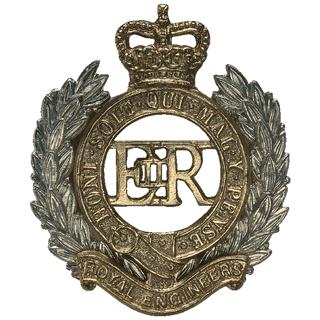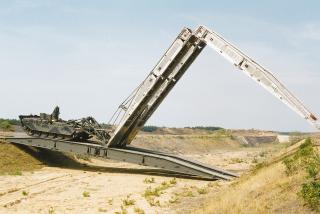
Role
The provision of military engineering support to the three Armed Services and other Government Departments in order to:
Enable the Army, the Royal Air Force and the Royal Navy to live, move and fight. Deny enemy forces the use of ground and existing infrastructure. Assist other Government departments and friendly countries as ordered through the Ministry of Defence, typical tasks might include:
Disaster relief
UN peace support operations.
History
The Royal Engineer's founding father was Gundulph, Military Engineer to William The Conqueror. Amongst other achievements, he built the White Tower, now standing, 900 years later, within the Tower of London.
Motto
UBIQUE (Everywhere) signifies that Royal Engineers have taken part in every battle fought by the British Army in all parts of the world.
All Royal Engineers are trained as soldiers and combat (battlefield) engineers. The main combat engineers tasks are grouped under the following headings:
Mobility
Counter Mobility
Survivability
Mobility. Mobility support is required throughout the battle area. This support ensures that troops can reach their objectives and that they can be supplied throughout the battle. It includes:
Obstacle Crossing. The analysis, reconnaissance, bypassing, breaching, reduction or crossing of obstacles in order to permit the passage of troops and equipment. This includes the crossing
of water and other gaps in the terrain, and mined areas. Routes. The development of routes for tactical and operational movement, and supply.
Counter Mobility. Counter mobility is the term used to describe efforts to hinder the enemy's movements and to encourage him to move through ground or routes of our choosing. Counter mobility includes:
Demolitions. Demolitions, including the use of explosives, and construction to create obstacles, deny routes, crater roads and destroy bridges.
Earthworks. Antitank ditches and earth bunds can be created using earthmoving plant.
Survivability. Royal Engineers provide assistance and advice to protect and sustain troops. The primary tasks are:
Field Defences. Assistance and advice on the best methods of camouflage and concealment and on the design and construction of field fortifications for the protection of men, equipment and weapon systems.
Water Supply. Royal Engineers are responsible for water supply. Camp Construction. Royal Engineers can provide sanitation, power and a wide range of structures to accommodate troops.
General Engineering
In addition to being soldiers and combat engineers all Royal Engineers are trained as artisans or specialists. This gives the Corps a construction engineering capability. General engineer tasks call for the provision of:
Logistic facilities
Accommodation
Accommodation services
Water
Power
Fuel
Port and rail facilities
Main supply routes
Geographic support
Support to the Royal Air Force.
The RAF has no indigenous capability to maintain or repair its own main operating bases or to establish forward operating bases. Such responsibility lies with Royal Engineers. The Royal Engineers provide support to assist the RAF to operate, live and survive. Such support can be to both fixed and deployed bases and comprises civil, structural, mechanical, and electrical engineering, and Airfield Damage Repair (Repair of Aircraft Operating Surfaces and Restoration of Essential Services).
Specialist Engineers
Armoured Engineers. To support fast-moving armoured formations the Royal Engineers have armoured squadrons equipped with tanks and other armoured vehicles designed to overcome obstacles.
Amphibious Engineers. The requirement to cross wide rivers is met by amphibious engineers equipped with rigs that drive off the road into water to link up as a bridge or ferry.
Parachute Engineers. There is a parachute squadron to support the rapidly deployable 5 Airborne Brigade. Any member of the Royal Engineers can apply to join this squadron, attend the parachute training course and if successful wear the Parachute red beret.
Commando Engineers. There is a commando squadron to support the Royal Marines worldwide. The squadron is trained and equipped to operate in hostile cold, mountainous or jungle environments, with a particular emphasis on amphibious operations. Any member of the Royal Engineers can apply to join this squadron, attend the commando course and if successful wear the Commando green beret.
Queen's Gurkha Engineers. The soldiers of the Queen's Gurkha Engineer squadron are recruited from Nepal and have strong and unique traditions that identify them as Gurkha soldiers. This squadron specialises in jungle warfare.
Diving. Royal Engineer diving teams are established in most regiments and independent squadrons. Tasks include: river reconnaissance, underwater construction and demolition, underwater search and clearance. Any member of the Royal Engineers can apply to become a diver.
Military Survey. A branch of the Royal Engineers, this is the Government's terrain visualisation agency producing maps, air charts, digital geographic data, geographic intelligence.
Explosive Ordnance Disposal. Royal Engineers are primarily responsible for all explosive ordnance disposal on the battlefield. The scope of the task has widened considerably since the Corps took on this role in the Blitz of 1940. Any officer or soldier may apply to be trained in EOD skills.

R.E. building a Bailey Bridge in Bosnia.

A Royal Engineers Chieftain Bridge Layer.
Regimental march - "Wings".
Other sites about the Royal Engineers can be found here:
Royal Engineers Regimental Museum.